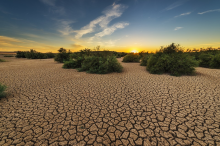 |
| A hothouse climate would have serious consequences for farming |
Even if greenhouse gas emissions are reduced, there is a risk that global warming could trigger other processes which could push the Earth System irreversibly
towards a “hothouse” climate, an international team of scientists has warned. The study, published in the journal Proceedings of the National Academy of Sciences, found that even if the targets of the Paris Agreement are met, this may not be enough to “park” the climate system at 1.5°C to 2°C above preindustrial levels. “A 2 °C warming could activate important tipping elements, raising the temperature further to activate other tipping elements in a domino-like cascade that could take the Earth System to even higher temperatures,” the authors write. This hothouse climate would in the long run see global average temperatures of 4-5°C higher than in pre-industrial times and sea levels rising 10 to 60 metres as compared to today. The scientists around lead author Will Steffen from the Australian National University and Johan Rockström from the Stockholm Resilience therefore call for an accelerated transition towards an emission-free world economy.
The authors analysed ten natural feedback processes, some of which are “tipping elements” that lead to abrupt change if a critical threshold is crossed. These feedbacks could turn from being a “friend” that stores carbon to a “foe” that emits it uncontrollably in a warmer world. The feedbacks include permafrost thaw, loss of methane hydrates from the ocean floor, weakening land and ocean carbon sinks, increasing bacterial respiration in the oceans, Amazon rainforest dieback, boreal forest dieback, reduction of northern hemisphere snow cover, loss of Arctic summer sea ice, and reduction of Antarctic sea ice and polar ice sheets. “These tipping elements can potentially act like a row of dominoes,” said Johan Rockström. “Once one is pushed over, it pushes Earth towards another. It may be very difficult or impossible to stop the whole row of dominoes from tumbling over. Places on Earth will become uninhabitable if “Hothouse Earth” becomes the reality,” he adds.
“The impacts of a Hothouse Earth pathway on human societies would likely be massive, sometimes abrupt, and undoubtedly disruptive,” the authors warn. It would also have serious consequences for food and farming. “Agricultural systems are particularly vulnerable, because they are spatially organized around the relatively stable Holocene patterns of terrestrial primary productivity, which depend on a well-established and predictable spatial distribution of temperature and precipitation in relation to the location of fertile soils as well as on a particular atmospheric CO2 concentration,” the authors write in the journal. “Current understanding suggests that, while a Stabilized Earth pathway could result in an approximate balance between increases and decreases in regional production as human systems adapt, a Hothouse Earth trajectory will likely exceed the limits of adaptation and result in a substantial overall decrease in agricultural production, increased prices, and even more disparity between wealthy and poor countries.”
“Avoiding this scenario requires a redirection of human actions from exploitation to stewardship of the Earth system,” said lead author Will Steffen. Maximising the chances of avoiding a “Hothouse Earth” requires not only a reduction of carbon dioxide and other greenhouse gas emissions but also the enhancement and creation of new biological carbon stores, for example, through improved forest, agricultural and soil management; biodiversity conservation; and technologies that remove carbon dioxide from the atmosphere and store it underground, the paper says. The authors also stress that these measures must be underpinned by fundamental societal changes that are needed to keep global warming below 2°C.









No comments:
Post a Comment